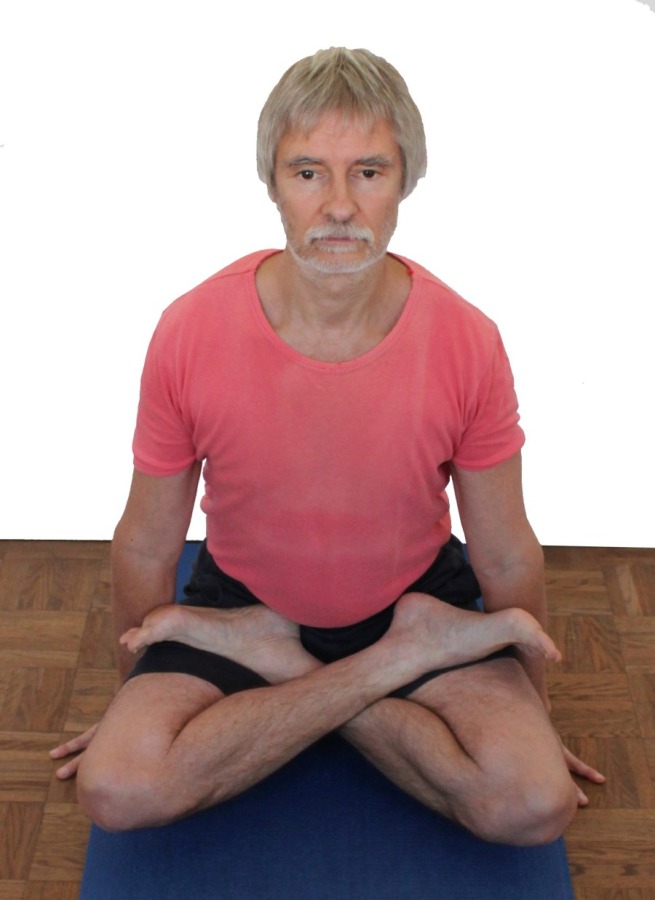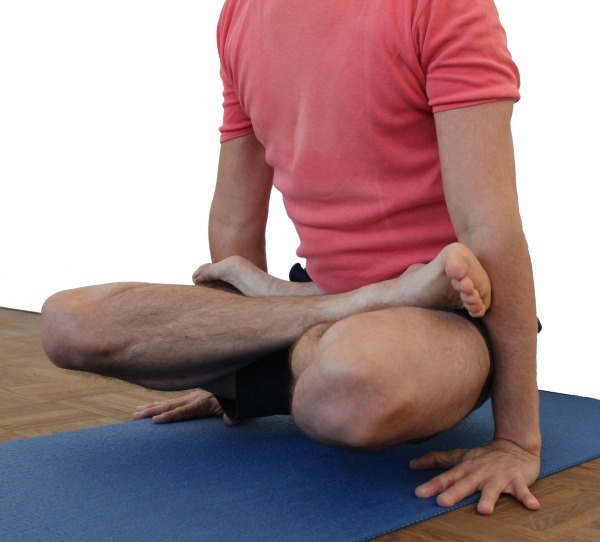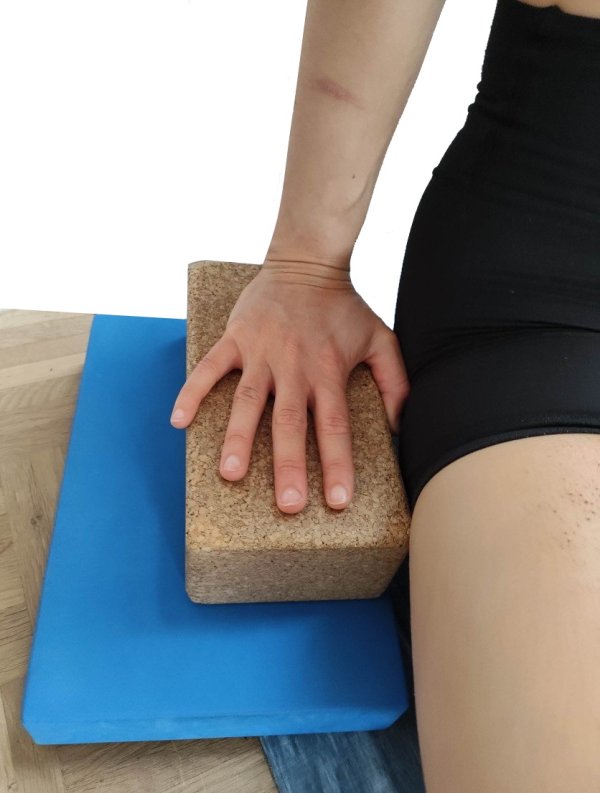Contents
tolasana
„Scales“

 instructions and details with working links as PDF for download/print
instructions and details with working links as PDF for download/print
Tue und lasse
Rücken krümmen statt strecken | Beine waagerecht, Hände nach vorn |
Feedback: We would love to hear what you think about this description, please give us feedback at:
postmeister@yogabook.org
last update: 30.12.2018
Name: tolasana
Trivial name: Libra
Level: A
- Classification: A
- Contraindication
- Effects of
- Preparation
- follow-up
- derived asanas
- similar asanas
- diagnostics
- Instruction
- details
- Variants
Effects
- (423) Tones the finger flexors (finger flexors)
- (292) Strengthening of the trapezius (pars ascendens) and pectoralis minor
- (352) Strengthening of the palmar flexors
- (342) Strengthening for dorsiflexion of the wrist
- (602) Strengthening the back extensors
- (817) Strengthening the rectus femoris
- (421) Stretching the finger flexors
Preparation
If the triceps are known to be prone to cramps, they should be stretched beforehand:
- upper half of gomukhasana the upper arm is stretched
The work of the shoulders (powerful depression of the shoulder blades) can be prepared with:
To curve kyphotically against the existing inclination of the back:
- „Table“ variation of the uttanasana
- Right-angled uttanasana
- warrior 3 pose, also in the variation backwards against the wall
- upavistakonasana in the „pull on the feet“ variation
- upavistakonasana in the „with block“ variation
as well as most backbends. The exorotation of the thigh in the hip joint should be prepared for the lotus position:
- half lotus forward bend
- baddha konasana
- supta baddha konasana
- adho mukha supta baddha konasana
- hip opener at the edge of the mat
- hip opener 3
- caturkonasana
- parsvakonasana
- counter
To be able to lift the legs against gravity and the extension moments of the extensors of the hip joint, practise:
- supta dandasana at different angles
- navasana
To be able to bend the knees far, the quadriceps need a certain amount of stretch:
- virasana
- supta virasana
- Quadriceps stretch 1 on the wall
- Quadriceps stretch 2 on the wall
- ardha supta krouncasana
- supta krouncasana
- malasana
The extension of the ankles can be improved with:
- baddha padasana, probably the most precise exercise for plantar flexion in the ankle joint
- virasana does this if attention is paid to the extension of the ankle joint
- supta virasana also achieves this if attention is paid to the extension of the ankle, but has other, greater challenges.
The hamstrings needs
very good stretching ability for the variation with extended legs
- uttanasana as a generally effective and efficient stretch for the hamstrings to prepare for flexion in the hip joints in this pose
- prasarita padottanasana very similar to uttanasana
- parsvottanasana as a stretch that goes beyond uttanasana
- pascimottanasana
- janu sirsasana
- tryangamukhaikapada pascimottanasana
- downface dog as another good preparation for the hamstrings when the pelvis is tilted powerfully
- hip opener 5 as a very effective stretch of the hamstrings that goes beyond uttanasana
- warrior 3 pose
- parivrtta trikonasana
Follow-up
derived asanas:
similar asanas:
Diagnostics (No.)
A little triceps strength is required in this posture to keep the arms extended. The tendency to bendis not solely due to the gravitational force of the large partial body weight; after all, the elbow joint is in an unstable equilibrium, at least if the arm flexors are not restricted in their flexibility. If they were, there would of course be a significant flexion moment in the elbow joint. But even without this, the traction of the palmar flexors of the wrist together with the finger flexors in the forearm causes the forearms to tilt backwards, which is equivalent to flexion of the elbow joint. Trembling in the arms or involuntary flexion of the elbow joints usually indicates a lack of strength in the triceps; a tendency to cramp or cramp in the biarticular middle triceps can mean increased tone and also a lack of strength.
In extensive dorsiflexion and under greater load, weaknesses and disorders of the wrists are most likely to become apparent:
- Ganglion, usually in the dorsal area between the hand and forearm, produces a sensation of pressure when the wrist is dorsiflexed
- Tendinitis of the tendons of the palmar flexors or finger flexors
- Carpal tunnel syndrome: worsening of symptoms in this position
- Fractures and fractures of carpal bones, especially the scaphoid bone
- Arthritic changes (degenerative with cartilage atrophy) of the joint
- Arthritis (joint inflammation) of various kinds
- Dislocation / subluxation, which would cause a significantly increased sensation of tension in various muscles covering the wrist joint
- joint trauma, which may cause pain in the joint even after many weeks or months
but also purely muscular symptoms such as
- Shortening/hypertonus of the dorsal flexors of the wrist, which then become noticeable in the dorsal side of the wrist like cramps
- Shortening/hypertonus of the palmar flexors of the wrist, which makes the dorsiflexion of the wrist painful in the executing muscles on the palmar side of the forearm
- Golfer’s elbow: Strain pain at the point of origin of the palmar flexors of the wrist and the finger flexors on the medial epicondyle at the junction of the humerus
(650) Kyphosis and lordosis of the spine:
The deviations from the physiological double-S shape of the human spine become less visible in this posture. On the one hand, the iliopsoas inevitably pulls the lumbar spine into hyperlordosis; on the other hand, you inevitably work against this with the abdominal muscles. The less flexible the hamstrings (variant with extended legs) is and the more the body proportions tend towards a sitting posture, the greater the effort required.
(611) Unequal shoulder height/scoliosis of the spine
The lateral deviations of the spine from the median plane known as scolioses can also become visible in this posture. See the FAQ.
This posture requires a little strength endurance in the back extensors. The abdominal muscles (especially the rectus abdominis) help to prevent the pelvis from falling forwards and downwards into a hollow back, which would presumably cause the knees (or heels in the version with outstretched legs) to touch the floor. The resulting flexion in the spine must be compensated for by the back extensor.
The main reason for the inability to bend the knee joint so far that the ankles (instead of the forefoot) rest on the thigh is the restriction of flexibility or the tone of the monoarticular quadriceps parts, which cause an extension moment in the knee joint.
In the standard variant, knee problems associated with wide flexion (and additional endorotation of the lower leg in the knee joint) are revealed very well. These can be, for example: traumatic or degenerative meniscus damage, arthrosis, arthritis, subluxations, ligament damage, plica syndromes and others, see the FAQ.
(913) Musculature of the sole of the foot
In this pose, cramps can occur in the muscles of the sole of the foot. This can be a consequence of excessive tone resulting from inadequate footwear or deformities of the feet and corresponding pathologically altered muscle loads, or as a result of using the feet in everyday life or sport.
(921) Ankle joint: extension deficit in the direction of plantar flexion or supination deficit
In this pose, plantar extension of the ankle to 180° (viewed ventrally ) is required; an extension deficit manifests itself in increased pressure of the back of the foot on the thigh. A lack of supination ability leads to discomfort in the area of the lateral malleolus. Lack of
exorotation ability in the hip joints prevents the assumption of the lotus position or leads to discomfort in the area of the inner meniscus or excessive pressure between the lower legs.
Variants:
Instructions
- Take lotus (padmasana).
- Press the palms onto the floor next to the pelvis so that the hands are facing forward and a little further forward than the buttocks.
- Press the hands increasingly firmly onto the floor and slowly but surely bring all possible strength into the arms and the depression of the shoulder blades to lift the torso between the arms and with it the legs.
Details
- When the pressure of the hands on the floor has become so strong that the pelvis lifts, it will seek the correct position of its own accord. This results in a brief rocking of the pelvis forwards and backwards. This rocking can be reduced by the force of the deltoid muscle: the pars clavicularis frontally abducts in the shoulder joint and thus moves the upper body backwards in relation to the fixed arm, the pars spinalis retroverts the arm and therefore moves the upper body forwards in relation to the fixed arm.
The other retroverters are also involved. Of particular interest here is the middle head of the triceps, which has a clear tendency to spasm due to its short sarcomere length. Among the frontal abductors, the coracobrachialis is hardly noticeable, but rather the biarticular biceps, whose use for stabilizing the trunk can result in a flexion tendency in the elbow joint.
The rocking movement occurs to the extent that the center of gravity of the supported partial body weight lies outside the physical base of support, or more precisely, is shifted forward from its center. This discrepancy or distance must be present when the hands are placed next to the pelvis. At the end of the swing, the position of the hands will be slightly in front of the buttocks. - The swing described above can also be expanded and explored for the purpose of practicing the use of arms and hands. It can be extended at will and also significantly increased, which serves to promote strength and body awareness in the area of anteversion and retroversion as well as the palmar flexors of the forearm.
- Turn both arms out (inner elbow and biceps forward).
- If there is a tendency to hyperextend the arms, as in other postures, it is necessary to use the ellbow flexors to avoid this or to reduce or avoid any resulting pain in the dorsal elbow gap (at the olecranon).
- The upper body should be fully extended in this position. Lifting the knees should not be made possible by rounding the back, see also the next note.
- The ability to lift the crossed legs is generally not just a question of proportions, as is often claimed, but of the ability to powerfully perform the corresponding movement in the shoulders, namely the depression of the shoulder blades, and to stabilize the posture with the help of the parts of the deltoid muscle as described above. In order to invalidate the proportion argument, or if the arms are actually „too shurt“, the back can be allowed to round accordingly, which, together with the maximum lifting of the legs, should make it possible to release the knees from the floor. In principle, however, sitting giants should consider performing the posture with the hands on blocks so that the back can be stretched.
- Extend your fingers, keeping them slightly apart.
- Information on dealing with cubitus valgus can be found in movement physiology under axial misalignment. In this pose, it means pushing your arms outwards against the resistance of the underlying surface.
Variations
with legs straight

Effects: (672) Strengthening the long abdominal muscle rectus abdominis
(712) Strengthening the hip flexors
Instructions
- Sit in dandasana.
- Place the hands next to the pelvis.
- Stretch the back and raise the upper body to the maximum(depression of the shoulder blades).
- Lift the legs off the floor without momentum.
Details
- In order for the plumb bob to be between the palms of the hands, as required for a stable posture, the pelvis must move slightly backwards from the starting position, somewhat more than in the variation with the legs in lotus position.
- Try not to lift the legs with momentum, but with slowly increasing force.
- The thoracic spine and lumbar spine have a tendency to fall into a convex curve. Stretch the back with the strength of the autochthonous back muscles and lift the sternum.
- The knee joints should be extended. The stretching required for this with quadriceps strength quickly leads to a cramp due to the very strong use of the hip flexors in the associated rectus femoris; after all, it works in a very short sarcomere length and the force to be applied is very high due to the long lever arm and the approximately horizontal position of the legs. Therefore, prepare the hamstrings very well so that the resistance to lifting is as low as possible and reduce any excessive tension in the rectus femoris beforehand.
- The amount of force required from both the hip flexors and the autochthonous back muscles exceeds what many people can initially achieve. Nevertheless, work without momentum and use every attempt to strengthen.
Hands elevated

Instructions
- Take the basic pose as described above, but place your hands on an elevation like a block.
Details
- This variation also enables sitting giants to perform tolasana. If the upper body is excessively long compared to the arms, it would otherwise not be possible to lift the buttocks off the floor.
Forward bend
Instructions
- Take the basic position as described above, but pull the legs as far as possible towards the chest.
Details
- This variation requires slightly more hip mobility than the standard variation. There is a slight tendency to arch the back, so avoid this as much as possible. However, if the hip extensors are restricted in their mobility and there is no way to lift the knees off the floor without using a block, the back can also be arched a little if there is no disc disease.
With outstretched legs and raised hands
Instructions
- Take the variation with straight legs and place your hands on an elevation like a block.
Details
- This variant not only allows seated giants to perform tolasana. The greatest difficulty of the variant with outstretched legs is usually not so much lifting the legs against gravity, but the ischiocrural group generated by the extensory moment in the hip joint, which pulls the legs towards the ground. The elevation under the hands now defuses the situation a little so that the heels can be lifted off the floor even with a lower flexion angle in the hip joint.
